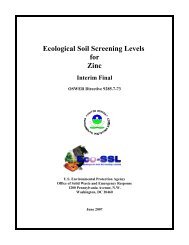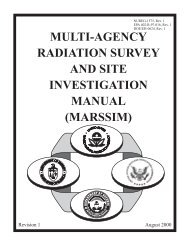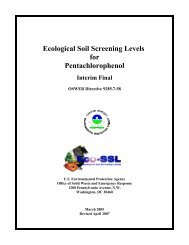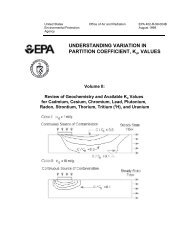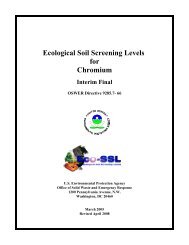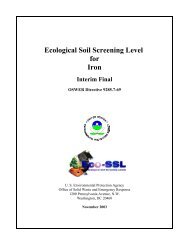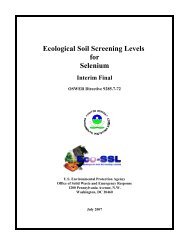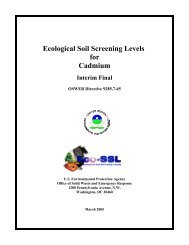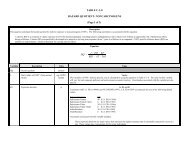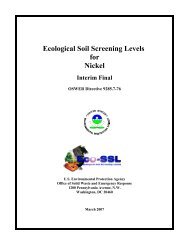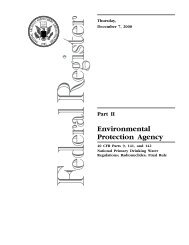Guidance for Conducting Risk Assessments and Related Risk ...
Guidance for Conducting Risk Assessments and Related Risk ...
Guidance for Conducting Risk Assessments and Related Risk ...
Create successful ePaper yourself
Turn your PDF publications into a flip-book with our unique Google optimized e-Paper software.
waterways that may have been contaminated by releases from the DOE-ORO installations. In 1989, the<br />
ORR was evaluated by the EPA using the Hazard Ranking System. As a result of this evaluation, the<br />
ORR was placed on the National Priorities List (NPL) <strong>and</strong> was required to comply with the requirements<br />
of the Comprehensive Environmental Response, Compensation, <strong>and</strong> Liability Act (CERCLA) (DOE<br />
1998b).<br />
The ORR strategy <strong>for</strong> environmental restoration is to accelerate the transition from characterization<br />
to remediation by making decisions at the watershed level based on assumed end uses (also referred to as<br />
l<strong>and</strong> uses) <strong>and</strong> existing/historical data. Until recently, the strategy <strong>for</strong> cleaning up ORR contaminated<br />
sites was to investigate each area individually, identify chemicals of concern (<strong>and</strong> their potential human<br />
health <strong>and</strong> ecological risks) <strong>for</strong> each site, <strong>and</strong> assume that the future l<strong>and</strong> use of all sites on the ORR<br />
would be unrestricted (e.g., residential, gardening, recreational, etc). The disadvantages of this site-bysite<br />
approach are that it is time consuming, not cost-effective, <strong>and</strong> actions at one site could negatively<br />
impact other nearby areas.<br />
The ORR has adopted a new cleanup strategy called “The Watershed Approach”. This new strategy<br />
involves making cleanup decisions <strong>for</strong> an entire watershed (a term used to describe a specific area where<br />
surface water <strong>and</strong> often groundwater comprise a specific flow system). Because there are multiple<br />
contaminated media <strong>and</strong> areas within a watershed, this new strategy’s cleanup actions rely heavily on the<br />
massive amounts of existing/historical <strong>and</strong> current sampling data. The future l<strong>and</strong> use <strong>for</strong> a particular<br />
watershed (or area within the watershed) will be more accurately <strong>and</strong> realistically determined by the<br />
DOE-ORO, the Tennessee Department of Environment <strong>and</strong> Conservation (TDEC), the U.S.<br />
Environmental Protection Agency (EPA) Region IV, <strong>and</strong> the public. Cleanup criteria will be based on the<br />
recommended future l<strong>and</strong> use.<br />
The watershed cleanup strategy uses a combination of integration point assessments, screening risk<br />
assessments, <strong>and</strong> baseline risk assessments to:<br />
• identify <strong>and</strong> prioritize contaminated sites <strong>and</strong> facilities within a watershed,<br />
• determine local area end/l<strong>and</strong> use (relying heavily on existing/historical environmental data), <strong>and</strong><br />
• develop an optimum remediation strategy (a remedy) <strong>for</strong> the identified problems.<br />
Portsmouth Gaseous Diffusion Plant: The Portsmouth Gaseous Diffusion Plant was constructed in<br />
the early 1950s to enrich uranium in support of both government <strong>and</strong> private programs. The plant<br />
currently operates under a lease agreement with the U.S. Enrichment Corporation, which produces lowenriched<br />
uranium <strong>for</strong> commercial applications. The DOE is responsible <strong>for</strong> remedial action to address<br />
environmental releases <strong>and</strong> <strong>for</strong> decontamination <strong>and</strong> decommissioning (D&D) of the facilities.<br />
The Portsmouth Gaseous Diffusion Plant is divided into four clean up areas, commonly referred to as<br />
quadrants, based on groundwater flow direction. Remediation is accomplished <strong>for</strong> the quadrants by:<br />
• removing well-defined sources of contamination,<br />
• consolidating <strong>and</strong> integrating CERCLA-based remedial actions with Resource Conservation <strong>and</strong><br />
Recovery Act (RCRA) corrective measures <strong>and</strong> closures <strong>for</strong> individual or groups of Solid Waste<br />
Management Units with common sources or interrelated groundwater plumes,<br />
• using risk-based closure criteria rather than “clean closure criteria” (where practical), <strong>and</strong><br />
• establishing cleanup levels <strong>and</strong> the sequence of cleanup ef<strong>for</strong>ts based on risk analysis results.<br />
8



